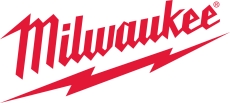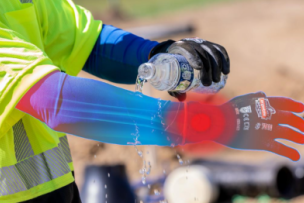In addition:
- The Core Drill has the power to core 6-inch holes in reinforced concrete, adding productivity whether handheld or used on a stand.
- Freedom from cords adds more safety and productivity. Often, electricians need to core on a building exterior above a door. That used to mean stringing hundreds of feet of cords into a house, often up stairwells, causing a trip hazard. Or, it meant using a generator, so requiring both gas and corded support. Battery power means that the time once spent looking for a power source or resetting circuit breakers is now spent getting to work.
Building a company-wide safety culture to protect workers is a choice that is reinforced in daily decisions, such as equipment selection.
Safety Technology can support an organization’s safety goals:
PROTECT WORKERS AND HELP BUILD A SAFETY CULTURE.
Safety Technology can become a cultural grounding point for an organization, letting workers know that the everyday risk is recognized and that they work for an organization that cares. Workers are a company’s most important resource. Purchasing equipment with Safety Technology and educating workers on benefits and use is a responsible investment in future worker health.
USE EQUIPMENT BUDGETS TO STRATEGICALLY SUPPORT THE BUSINESS.
Organizations recognize that the ramifications for injuries on the job impact more than just the worker – they also have a domino effect on the company’s bottom line. While it’s not surprising that the upfront cost of new solutions can be an initial hurdle for some companies, the long-term cost savings, productivity improvements, and overall impact on worker morale can provide significant savings.
As NIOSH affirms: “The initial cost of engineering controls can be higher than some other control methods, but over the longer term, operating costs are frequently lower, and in some instances, can provide a cost savings in other areas of the process.”7
SAVE THE DIRECT AND INDIRECT COST OF INJURIES.
Equipment featuring Safety Technology can help prevent insurance rate hikes due to claims, along with the productivity cost of days away from work. In 2016, musculoskeletal disorders (MSDs) of all types, which can be caused by core drilling injuries, comprised about 40% of all lost-time workplace injuries (356,910 of 902,200).8 The numbers are likely low, as several studies have found that both workers and employers may under-report MSDs, according to the NORA for Musculoskeletal Health.9 Battery-powered light equipment featuring Safety Technology can help reduce claim costs and help avoid injuries, such as MSDs.
Download a PDF of the complete whitepaper here.
References
1National Institute of Occupational Safety and Health. https://www.cdc.gov/niosh/engcontrols/
2CPWR Construction Chart Book, Sixth Edition. 2018. Page 50. Occupational Diseases – Noise-Induced Hearing Loss in Construction and Other Industries.
3 OSHA. https://www.osha.gov/laws-regs/regulations/standardnumber/1926/1926.1153
4CPWR Construction Chart Book, Sixth Edition. 2018. Page 34. Exposure to Silica and Other Contaminants in Construction.
5 Ibid.
6 American Lung Association. https://www.lung.org/lung-health-diseases/lung-disease-lookup/silicosis/ symptoms-diagnosis
7National Institute of Occupational Safety and Health. https://www.cdc.gov/niosh/engcontrols/
8BLS (Bureau of Labor Statistics) [2016]. Cited in National Occupational Research Agenda (NORA) for Musculoskeletal Health. October 2018. Developed by the NORA Musculoskeletal Health Cross-Sector Council. Page 4. https://www.cdc.gov/nora/councils/mus/pdfs/National-Occupational-Researc...
9National Occupational Research Agenda (NORA) for Musculoskeletal Health. October 2018. Developed by the NORA Musculoskeletal Health Cross-Sector Council. Page 5. https://www.cdc.gov/nora/councils/mus/ pdfs/National-Occupational-Research-Agenda-for-Musculoskeletal-Health-October-2018.pdf




max_efficiency_thumb.png?itok=_OhRZeS3)




Talk to Us!
Leave a reply
Your email address will not be published. Required fields are marked *